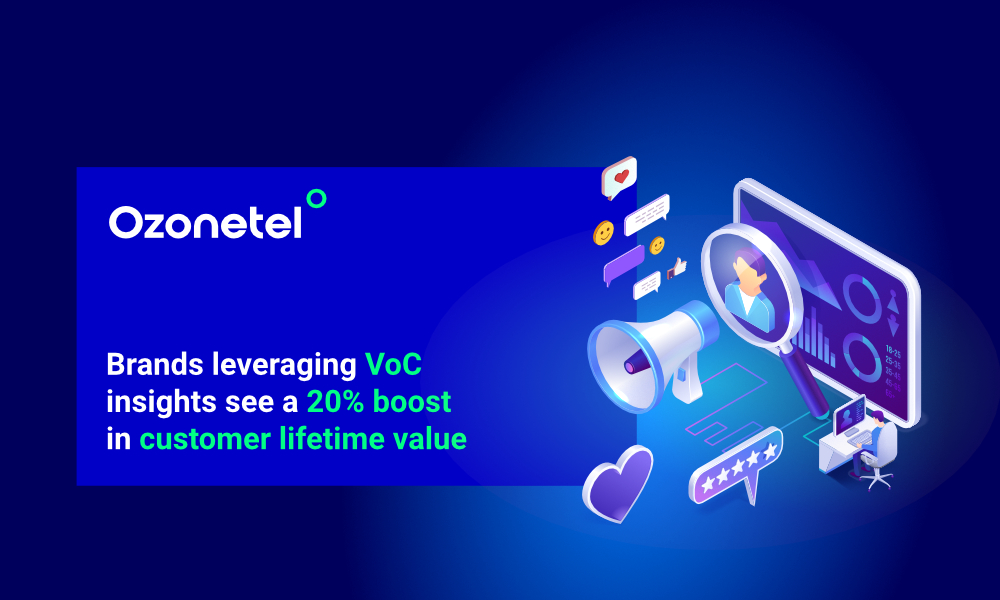- Resources
- A Comprehensive Guide to Voice of the Customer (VoC) in 2024
A Comprehensive Guide to Voice of the Customer (VoC) in 2024

Frustrated by customer churn and feeling like you’re missing the mark? In today’s digital age, customers have more choices than ever, and a bad experience can send them to the competition. Did you know that poor experiences cost U.S. businesses an estimated $83 billion annually?
Here’s the good news: there’s a powerful tool that can help you understand your customers better, improve their experience, and boost your bottom line. It’s called Voice of the Customer (VoC), and this guide will be your roadmap to unlocking its potential.
So, what exactly is VoC? It’s all about capturing and analyzing customer feedback – their needs, wants, and frustrations – to gain valuable insights into how you can improve your products, services, and interactions. Think of it as a direct line to your customers’ hearts and minds, helping you understand what truly matters to them.
This guide will break down everything you need about VoC programs, from capturing feedback through surveys, social media, and reviews to analyzing the data and taking action on those insights. We’ll show you how VoC can be the key to building stronger customer relationships, increasing loyalty, and, finally, boosting sales and success for your business.
So what are you waiting for? Read along!
What is Voice of the Customer (VoC)?
Voice of the Customer is a comprehensive process or program businesses use to systematically collect, analyze, and act upon customer feedback. It is a customer-centric approach that focuses on understanding customers’ experiences, needs, expectations, and pain points to enhance or improve products, services, and overall customer experience.
Businesses that listen to the VoC can better understand and meet their customer’s needs and expectations and improve the products and services they provide. Also, a VoC program provides insight into client preferences, issues, and complaints. These VoC initiatives identify and respond to client feedback to increase customer happiness and loyalty.
Businesses record the Voice of the Customer and use the data to improve the customer experience throughout all contacts with the company. VoC is best understood via technology such as text analytics and sentiment analysis, ensuring insights can be extracted from customer feedback data.
The primary objectives of a VoC program are:
Understanding the ‘why’ behind customer feedback: VoC goes beyond merely capturing customer opinions; it delves deeper to uncover the underlying reasons, motivations, and emotions driving their feedback. This insight is crucial for addressing the root causes of customer experiences, both positive and negative.
Identifying customer needs, wants, and pain points: By actively hearing customer feedback, companies can get a comprehensive understanding of what customers truly desire, what they find frustrating or challenging, and what their unmet needs are. This knowledge enables organizations to prioritize areas for improvement and innovation.
Synthesizing feedback for informed decision-making: VoC programs collect feedback from various channels, such as surveys, interviews, social media, customer support interactions, and product usage data. This diverse data is then synthesized and shared across different departments and stakeholders, enabling data-driven decision-making and cross-functional alignment.
Benefits Of Voice of the Customer

VOC enables businesses to listen to their customers and act on the information offered. Important VOC advantages include the following:
Increased Revenue
VoC can be a powerful tool for identifying new opportunities for growth. By listening to the customer, businesses can uncover unmet needs or areas of dissatisfaction that can be addressed to improve the customer experience. When businesses meet customers’ expectations by creating goods and services tailored to their preferences and needs, they are better positioned to grow their revenue and bottom line.
Customer Loyalty and Retention
Businesses that listen to and act on customer feedback display a genuine interest in their customers’ ideas and a drive to generate products and services that meet customer’s needs. Over time, this can lead to increased customer loyalty, as customers feel valued and understood by the business.
Performance Visibility
VoC programs provide a clear view of how a business is performing from the customer’s perspective. This can highlight areas where the business is excelling and where improvements are needed. Such visibility can help businesses prioritize their efforts and resources to areas that will have the greatest impact on customer satisfaction and business performance.
Improved Products and Services
Companies that listen to customer input can identify weak points in their products and services and make specific changes to address these issues. This information can be used to enhance product features, fix bugs, or make the product more user-friendly. This may result in better goods and services that match customer preferences.
Better Customer Experience
A fundamental goal of a VOC program is to improve the customer experience at every stage of their journey, from the first interaction with the firm to the point of sale and beyond. Businesses can obtain significant insights into their consumers’ aspirations and expectations via VOC, allowing them to make required adjustments to better meet their demands.
Brand Management
VoC can provide insights into how customers perceive a business’s brand. This can help businesses understand if their brand messaging is resonating with customers and if the brand is meeting customer expectations. Such insights can inform brand management strategies, helping businesses to strengthen their brand image and positioning in the mark
Voice of the Customer Methodology
You can conduct in-depth conversations with consumers to better understand their experiences, motivations, and problem areas. These can be done in person, via phone, or video conferencing.
Customer interviews enable you to ask probing questions and follow up on responses, yielding valuable qualitative data. You can also utilize techniques such as customer journey mapping or persona building to better understand the client’s perspective.
A few more ways through which you can collect VoC data are:
Closed-Loop Process
A closed-loop process involves setting up multiple touch points throughout the customer journey where you actively solicit feedback. For example, after a customer makes a purchase, you send them a follow-up email or SMS asking about their experience.
You can also integrate feedback mechanisms directly into your product or service, such as pop-up surveys or rating prompts. The key is to keep the loop closed by addressing the feedback received and implementing improvements based on customer inputs.
Text Analytics and Sentiment Analysis
You can leverage text analytics and sentiment analysis tools to mine customer feedback from text-based sources, such as customer emails, chat logs, social media comments, and online reviews. These platforms use natural language processing (NLP) algorithms to identify and categorize the sentiment (positive, negative, or neutral) expressed in the text. This lets you gain insights into customer opinions, pain points, and preferences without having to manually read through vast amounts of unstructured data.
Surveys and Questionnaires
You can design and administer surveys and questionnaires to gather structured customer feedback. These can be conducted online, via email, or through various channels such as phone calls or in-person interactions. Surveys help you to ask targeted questions and gather quantitative and qualitative data on specific aspects of the customer experience. You can use various question formats, such as multiple-choice, open-ended questions, and rating scales to capture different types of feedback.
Social Media Listening
You can monitor and analyze customer conversations on social media platforms such as Instagram, Facebook, Twitter, and Reddit. This includes tracking brand mentions, products, or services, relevant industry topics, and keywords. Moreover, social media listening tools can help you understand customer pain points, complaints, and praises and gather insights into customer preferences and behaviors.
Customer Interviews
You conduct in-depth interviews with customers to better understand their experiences, motivations, and pain points. These can be done in person, over the phone, or through video conferencing. Customer interviews allow you to ask probing questions and follow up on responses, providing rich qualitative data.
You can also use customer journey mapping or persona development techniques to better understand the customer’s perspective.
Impact of VoC on Customer Experience

Through VoC, you gain a deep understanding of the issues and challenges your customers face. Customer feedback can help you identify the root causes of their pain points and take targeted actions to resolve them. This proactive approach to addressing customer concerns improves their experience and fosters trust and loyalty towards your brand.
Here are a few more key impacts of VoC on customer experience:
Enhancing Customer Delight
VoC enables you to uncover the aspects of your products, services, or processes that customers truly appreciate and value. By expanding and amplifying these positive elements, you can consistently deliver experiences that delight your customers and exceed their expectations. This heightened level of customer satisfaction can lead to increased advocacy and positive word-of-mouth, driving growth for your business.
Driving Customer Retention and Loyalty
Implementing customer feedback from VoC initiatives demonstrates your commitment to continuously improving their experience. When customers feel heard and see their suggestions being acted upon, they are likely to remain loyal to your brand. A robust VoC program helps you address potential issues before they escalate, reducing customer churn and fostering long-term relationships.
Fostering Innovation and Customization
VoC provides invaluable insights into customer preferences, needs, and desired improvements. This helps you identify opportunities for innovation, product development, and service customization. This customer-centric approach ensures that your offerings consistently meet and exceed customer expectations, giving you a competitive edge in the market.
Enabling Proactive Crisis Management
VoC acts as an early warning system, allowing you to detect and address potential crises before they escalate. By monitoring customer feedback across various channels, you can quickly identify emerging issues and take prompt action to mitigate risks and protect your brand reputation.
Aligning Organizational Silos
Implementing a comprehensive VoC program requires collaboration across various departments and teams within your organization. This cross-functional alignment ensures that customer feedback is integrated into decision-making processes, fostering a customer-centric culture throughout the company.
Driving Customer Success
Ultimately, VoC plays a pivotal role in achieving customer success. By listening to and responding to customer feedback, you can make sure that your offerings consistently meet their desired outcomes. This customer-centric approach enhances satisfaction and contributes to their overall success, strengthening the relationship with your brand.
VOC Best Practices
The Voice of the Customer gives early warnings and guidance for your success straight from the people who matter most—your consumers. Use these best practices to achieve ongoing improvement in your VoC program:
Collaborate With Other Departments
To establish an effective VoC program, you must foster collaboration across multiple departments that collect, analyze, and act upon customer insights. Implement action planning tools that facilitate cross-departmental collaboration, enabling teams to tag owners, set deadlines, and provide step-by-step guidance. This streamlined approach empowers everyone within the organization to contribute to delighting customers and improving the overall customer experience.
Invest in Omni-Channel Tools
You should implement an omnichannel feedback tool to collect customer feedback from various touchpoints and channels. Many businesses rely on one or two channels to measure customer interactions, limiting customer insights’ accuracy and depth.
You gain a more comprehensive understanding of customer preferences, behaviors, and satisfaction levels by connecting feedback across multiple data channels, such as websites, mobile apps, social media, email, and in-person interactions. Leveraging an omnichannel approach ensures you capture customer feedback wherever they are, enabling you to create a seamless and consistent customer experience.
Incorporate the Voice of the Employee
Connecting the employee and customer experiences gives your organization a comprehensive picture of what is happening and why. By understanding this connection, you gain insights into the impact of employee engagement on your company’s bottom line.
Incorporate the Voice of the employee into your VoC program, as employee feedback serves three essential purposes:
- Helps identify process, and technology challenges that obstruct seamless experience delivery
- Provides context for customer experiences
- Offers insights into the quality of employees’ experiences
Use dashboards and reports to surface insights
Leverage a VoC tool to understand what’s happening within your business. Implement configurable dashboards that present relevant insights to the appropriate stakeholders, ensuring that the right people can access the necessary information.
Configure automatic actions and alerts based on various factors, such as location, responses, behaviors, department, role, and more. Automate looping in the relevant stakeholders based on feedback from the leadership team and the frontline employees.
Deliver Clear ROI
For a successful customer experience program, delivering tangible returns to the business is essential. Adopt an ROI mindset from the outset, aligning your measurements, metrics, actions, and improvements to drive business results.
Rather than solely reporting on VoC metrics like Customer Satisfaction (CSAT), Net Promoter Score (NPS), and Customer Effort Score (CES), improvements in these metrics are tied to a financial metric. Also, try to focus on the following areas to demonstrate ROI:
- Market share: Optimize market penetration, increase share of wallet, and boost category spending.
- Cost: Understand the costs associated with serving, acquiring, and retaining customers and weigh them against the projected gains from improvements in these areas.
- Efficiency: Measure the time and resources required to complete tasks to satisfaction, from start to finish.
Moreover, customer lifetime value (CLV) has emerged as a premier financial metric in customer experience, as it considers various factors, including share of wallet, market penetration, cost of acquisition, and customer retention, providing a robust measure of ROI.
How Ozonetel Helps Enterprises Transform CX with Voice of Customer Analysis
If you’re still unsure how the VoC methodology may benefit your organization, consider looking at real-world examples. Several firms have benefited from implementing VoC in their organizations, including:
Boosting Loyalty with Regular NPS Surveys
One of India’s top NBFCs leveraged Ozontel’s voice blast to conduct daily Net Promoter Score (NPS) surveys, capturing crucial customer feedback at every stage of their journey. This helped them achieve a remarkable 65% increase in their NPS score, highlighting the effectiveness of proactive customer engagement.
Improving Service Quality through Detailed Feedback
SABOO RKS, an automobile dealer in Hyderabad, established a Quality Control (QC) team to collect feedback on the car buying experience, test drive booking, and after service by calling customers and understanding their satisfaction levels. Following Ozonetel’s implementation, the QC team now efficiently meets targets by gathering feedback from car buyers and service recipients. Conversation duration doubled from 1.5 to 3 minutes, enabling more detailed and high-quality interactions to collect post-purchase or service feedback.
Enhancing FCR rate with AI-based Sentiment Analysis
Ozonetel’s Speech Analytics solutions enabled the National Health Authority to delve deeper into customer conversations, evaluating the overall sentiment of calls using metrics like rate of speech, volume, pitch, tone, and spectral changes. By employing a proprietary algorithm, calls were classified as negative or neutral. Historical data analysis helped NHA predict future beneficiary queries and behaviors which led to more focused training programs for advisors and significantly boosted first contact resolution.
Enhancing CX & Improving Sales with GenAI-powered Voice of Customer Insights
BigBasket wanted to analyze the conversations their sales and CX team were having with their customers to find out about their pitches, complaints and the reason for complaints so that they could course-correct in real-time. Ozonetel understood the context and suggested leveraging their Gen-AI powered voice-of-the-customer solution. This enabled BigBasket to:
- Identify frequent issues & key areas of concern for their customers
- Analyze sales scripts and identify customer objections that impact sales
- Automate entry of conversation summary in CRM and CX tool
- Improve CX with faster & better resolution of complaints.
The solution helped BigBasket understand that most of their customer concerns were due to leakage in milk products, delays in delivery, and missed deliveries.
Timely resolution of these issues led to the following:
Revenue impact: 5% improvement in sales.
Wallet share: 1.5X improvement in order value.
LTV: 20% improvement in repeat orders.
Conclusion
The customer should be at the forefront of everything you do, and you cannot presume you know what your customers want. To stay one step ahead of the competition and meet your customer’s demands, listen to what they are saying about you and act quickly. You may accomplish this by building an effective Voice of the Customer program that gathers, analyses, and shares customer feedback so that your organization can make confident, customer-focused decisions.
By leveraging Ozonetel’s comprehensive VoC capabilities, including automated call monitoring, speech analytics, sentiment analysis, and integration with CRMs and dialers, organizations can efficiently collect, analyze, and act upon customer feedback at scale. This customer-centric approach improves customer experience, satisfaction, and loyalty, ultimately leading to business growth.
Want to see what Ozonetel can do for your company? Sign up today for a free 21-day trial.
Frequently Asked Questions
Common voices of customer questions often revolve around product functionality, troubleshooting, and service inquiries. Understanding these questions helps businesses effectively tailor their products and services to meet customer needs.
Voice of Customer Analytics involves collecting and analyzing customer feedback and data to gain valuable insights into customer preferences, expectations, and satisfaction. This data-driven approach helps companies make better business decisions to enhance customer experiences.
Popular Voice of Customer tools include platforms such as Ozonetel, SurveyMonkey, Qualtrics, and Medallia. These tools enable businesses to gather, analyze, and interpret customer feedback, providing valuable insights to improve products, services, and overall customer satisfaction.
Prashanth Kancherla
Chief Operating Officer, Ozonetel Communications
Over the past decade, Prashanth has worked with 3000+ customer experience and contact center leaders...
Chief Operating Officer, Ozonetel Communications
Over the past decade, Prashanth has worked with 3000+ customer experience and contact center leaders to comprehensively understand the need for effective and efficient customer communications at every step of their journey with a brand. Deeply embedded in today’s CCaaS ecosystem, he has been instrumental in Ozonetel's growth and contributed in various roles including product management, sales, and solution architecture.







